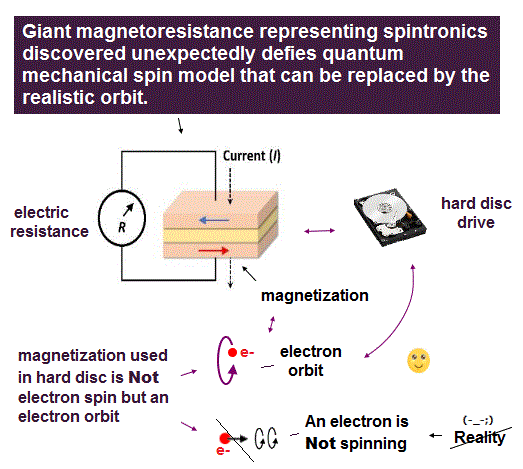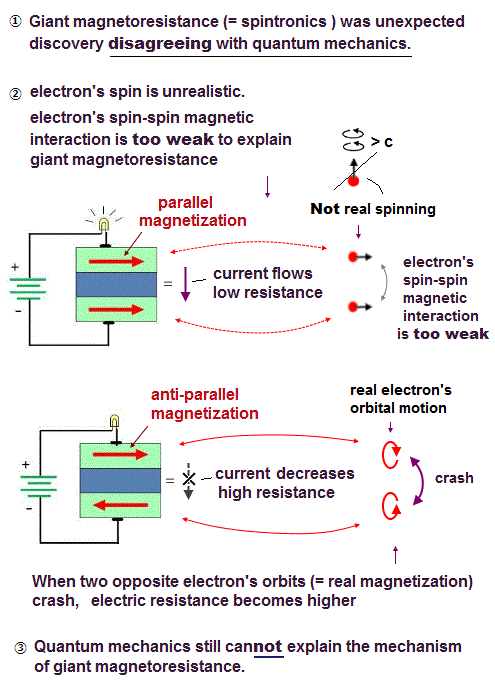
Home page
Electrons spin is unreal
Spin-MRAM is deadend
(Fig.1) Quantum mechanics still cannot explain the giant magnetoresistance (= spintronics ) used in hard disc drive, which is caused by electron's orbit, Not by unrealistic electron spin.

In giant magnetoresistance (= GMR ), the electric resistance increases when two adjacent thin materials' magnetizations are antiparallel, and the resistance decreases when two adjacent magnetizations are parallel ( this p.2 ), which phenomena are used in today's hard disc drive and MRAM.
Electron spin is unreal, and an electron is known to be Not actually spinning (= contrary to the misleading name of spintronics ), because the tiny electron must spin much faster than light to generate the observed magnetization.
So this material magnetization used in hard disc and MRAM is caused by the realistic electron's orbit instead of the unrealistic electron spin (= spin magnetic energy is too weak to cause ferromagnet or giant magnetoresistance, this p.17 ).
Actually, the unphysical quantum mechanics was completely useless for discovering the giant magnetoresistance or spintronics.
This p.3-2nd~3rd-paragraphs say
" The general
consensus (= quantum mechanics) in the 1980s was that it was not possible to significantly improve on the performance of
magnetic sensors based on magnetoresistance.
Therefore it was a great surprise when in 1988 two research groups independently discovered materials
showing a very large magnetoresistance, now known as giant magnetoresistance (GMR)" ← quantum mechanical prediction was wrong.
This p.1-introduction-1st-paragraph says
"This
discovery (= giant magnetoresistance ) took the scientific community by surprise; physicists did not widely believe
that such an effect was physically possible."
↑ So giant magnetoresistance used in hard disk was completely an unexpected discovery irrelevant to quantum mechanics or its (unphysical) spin theory ( this 10th-paragraph, this p.1-right, p.4, this p.2-left-2nd-last-paragraph ) like transistor.
This p.1-left-1st-paragraph says
"A satisfactory microscopic explanation of the physical processes
causing the GMR (= giant magnetoresistance ) is still lacking"
This p.12-last-paragraph says
"there is No theoretical model that addresses the proposed scenario and
further theoretical study is highly required to quantitatively describe the giant MR (= magnetoresistance )"
This-p.1-introduction-2nd-paragraph says
"Nowadays the underlying physics of GMR and the interlayer exchange coupling are broadly understood. Nevertheless, when it comes to detail, discrepancies between experimental observations and theoretical models can arise"
↑ Quantum mechanics and its (unphysical) spin theory still cannot explain the giant magnetoresistance used in hard disc ( this p.1-right-2nd-paragraph, this p.3-middle-2nd-paragraph, this 10th-paragraph ), so quantum mechanics made No contribution to any modern technology including spintronics.
The 2nd-last paragraph of this overhyped-headline news (3/23/25) says
"There are many challenges ahead, including innovative approaches for designing and synthesizing materials (= still useless )"
The last paragraph of this overhyped news (9/24/2024) says
"The results show that ( overhyped ) graphene-based heterostructures have great potential (= just speculation, still useless ) for the next generation of spintronic devices"
(Fig.2) Giant magnetoresistance used in hard disk drive is caused by realistic electron's orbit, Not by the unphysical spin.

The unphysical quantum mechanics is unable to explain the giant magnetoresistance (= GMR ) in spintronics, which can be naturally explained by the realistic electron's orbit.
When two electrons' orbits are antiparallel like in the upper figure, these two orbits in the opposite directions (= opposite de Broglie wave ) crash against each other, increasing resistance, while the parallel orbits without crashing do not increase the resistance (= realistic mechanism of magnetoresistance ).
It is impossible for an tiny point-like electron spin to generate such resistance by crashing (= point-like particles cannot distinguish the spinning direction even when crashing ).
Actually, even the (fake) first-principle quantum mechanical theory still cannot explain the giant magnetoresistance (= GMR ) in spintronics.
This recent paper about giant magnetoresistance ↓
p.1-left says "The quest to understand these mechanisms has continued for longer than a century but many gaps still remain, which is especially obvious for the MR (= magnetoresistance )"
p.4-right-1st-paragraph says "further work is required to develop a microscopic theory"
p.6-left-2nd-paragraph says "there are several mechanisms that can cause linear MR and, even today, its observation often leads to controversies because it is difficult to pinpoint the exact origin"
This paper also admits ↓
p.3-right(or 5)-last-paragraph says " they cannot be applied to the quantitative treatment of GMR, due to the complex spin-polarized electronic structure"
p.21-right(or 41 )-2nd-paragraph says "Unfortunately, the number of free parameters in such a phenomenological model is so large"
p.31-left(or 60 )-last-paragraph says "they assumed that the spin-dependent scattering potential V is a parameter"
p.36-right(or 71 )-5th-paragraph says "Unfortunately, proper first-principle treatment of all the possible mechanisms of scattering in
layered structures is very complicated....
they approximate these scattering processes"
p.40-right(or 79 )-1st-paragraph says "This reduces the number of adjustable parameters to only three"
↑ So even the so-called first-principle quantum mechanics must rely on artificial spin model with multiple freely-adjustable parameters, which means No quantum mechanical prediction, and No evidence of spin in magnetoresistance of hard disk drive.
Actually, all recent researches about (giant) magnetoresistance relied on freely-fitting parameters without quantum mechanical prediction ( this p.5, this p.6-right-last~p.7, this p.3-left-last-paragraph ).

Feel free to link to this site.